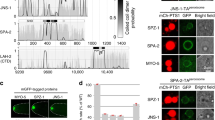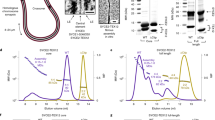Abstract
L27 domain, initially identified in the Caenorhabditis elegans Lin-2 and Lin-7 proteins, is a protein interaction module that exists in a large family of scaffold proteins. The domain can function as an organization center of large protein assemblies required for establishment and maintenance of cell polarity. We have solved the high-resolution NMR structure of a tetrameric complex of L27 domains containing two SAP97–mLin-2 L27 domain heterodimers. Each L27 domain contains three a-helices. The first two helices of each domain are packed together to form a four-helical bundle in the heterodimer. The third helix of each L27 domain forms another four-helical bundle that assembles the two heterodimers into a tetramer. The structure of the complex provides a mechanistic explanation for L27 domain–mediated polymerization of scaffold proteins, a process that is crucial for the assembly of supramolecular complexes in asymmetric cells.
This is a preview of subscription content, access via your institution
Access options
Subscribe to this journal
Receive 12 print issues and online access
$189.00 per year
only $15.75 per issue
Buy this article
- Purchase on Springer Link
- Instant access to full article PDF
Prices may be subject to local taxes which are calculated during checkout



Similar content being viewed by others
References
Doerks, T. et al. L27, a novel heterodimerization domain in receptor targeting proteins Lin-2 and Lin-7. Trends Biochem. Sci. 25, 317–318 (2000).
Butz, S., Okamoto, M. & Sudhof, T.C. A tripartite protein complex with the potential to couple synaptic vesicle exocytosis to cell adhesion in brain. Cell 94, 773–782 (1998).
Lee, S., Fan, S., Makarova, O., Straight, S. & Margolis, B. A novel and conserved protein-protein interaction domain of mammalian Lin-2/CASK binds and recruits SAP97 to the lateral surface of epithelia. Mol. Cell. Biol. 22, 1778–1791 (2002).
Simske, J.S., Kaech, S.M., Harp, S.A. & Kim, S.K. LET-23 receptor localization by the cell junction protein LIN-7 during C. elegans vulval induction. Cell 85, 195–204 (1996).
Kaech, S.M., Whitfield, C.W. & Kim, S.K. The LIN-2/LIN-7/LIN-10 complex mediates basolateral membrane localization of the C. elegans EGF receptor LET-23 in vulval epithelial cells. Cell 94, 761–771 (1998).
Borg, J.P. et al. Identification of an evolutionarily conserved heterotrimeric protein complex involved in protein targeting. J. Biol. Chem. 273, 31633–31636 (1998).
Hata, Y., Butz, S. & Sudhof, T.C. CASK: a novel dlg/PSD95 homolog with an N-terminal calmodulin-dependent protein kinase domain identified by interaction with neurexins. J. Neurosci. 16, 2488–2494 (1996).
Jo, K., Derin, R., Li, M. & Bredt, D.S. Characterization of MALS/Velis-1, -2, and -3: a family of mammalian LIN-7 homologs enriched at brain synapses in association with the postsynaptic density-95/NMDA receptor postsynaptic complex. J. Neurosci. 19, 4189–4199 (1999).
Irie, M. et al. Isolation and characterization of mammalian homologues of Caenorhabditis elegans lin-7: localization at cell-cell junctions. Oncogene 18, 2811–2817 (1999).
Setou, M., Nakagawa, T., Seog, D.H. & Hirokawa, N. Kinesin superfamily motor protein KIF17 and mLin-10 in NMDA receptor-containing vesicle transport. Science 288, 1796–1802 (2000).
Bamji, S.X. et al. Role of β-catenin in synaptic vesicle localization and presynaptic assembly. Neuron 40, 719–731 (2003).
Schultz, J., Milpetz, F., Bork, P. & Ponting, C.P. SMART, a simple modular architecture research tool: identification of signaling domains. Proc. Natl. Acad. Sci. USA 95, 5857–5864 (1998).
Chetkovich, D.M. et al. Postsynaptic targeting of alternative postsynaptic density-95 isoforms by distinct mechanisms. J. Neurosci. 22, 6415–6425 (2002).
Karnak, D., Lee, S. & Margolis, B. Identification of multiple binding partners for the amino-terminal domain of synapse-associated protein 97. J. Biol. Chem. 277, 46730–46735 (2002).
Harris, B.Z., Venkatasubrahmanyam, S. & Lim, W.A. Coordinated folding and association of the LIN-2, 7 (L27) domain: An obligate heterodimerization module involved in assembly of signaling and cell polarity complexes. J. Biol. Chem. 277, 34902–34908 (2002).
Roh, M.H. et al. The Maguk protein, Pals1, functions as an adapter, linking mammalian homologues of Crumbs and Discs Lost. J. Cell Biol. 157, 161–172 (2002).
Richardson, J.S. & Richardson, D.C. In Prediction of Protein Structure and Principles of Protein Conformation. (ed. Fasman, G.) 1–98 (Plenum, New York, 1989).
Wu, H., Reuver, S., Kuhlendahl, S., Chung, W. & Garner, C. Subcellular targeting and cytoskeletal attachment of SAP97 to the epithelial lateral membrane. J. Cell Sci. 111, 2365–2376 (1998).
Hsueh, Y.-P. et al. Direct interaction of CASK/LIN-2 and syndecan heparan sulfate proteoglycan and their overlapping distribution in neuronal synapses. J. Cell Biol. 142, 139–151 (1998).
Feng, W., Fan, J.S., Jiang, M., Shi, Y.W. & Zhang, M. PDZ7 of glutamate receptor interacting protein binds to its target via a novel hydrophobic surface area. J. Biol. Chem. 277, 41140–41146 (2002).
Clore, G.M. & Gronenborn, A.M. Determining the structures of large proteins and protein complexes by NMR. Trends Biotechnol. 16, 22–34 (1998).
Kay, L.E. & Gardner, K.H. Solution NMR spectroscopy beyond 25 kDa. Curr. Opin. Struct. Biol. 7, 722–731 (1997).
Neri, D., Szyperski, T., Otting, G., Senn, H. & Wuthrich, K. Stereospecific nuclear magnetic resonance assignments of the methyl groups of valine and leucine in the DNA-binding domain of the 434 repressor by biosynthetically directed fractional 13C labeling. Biochemistry 28, 7510–7516 (1989).
Zwahlen, C. et al. Methods for measurement of intermolecular NOEs by multinuclear NMR spectroscopy: application to a bacteriophage N-peptide/boxB RNA complex. J. Am. Chem. Soc. 119, 6711–6721 (1997).
Cornilescu, G., Delaglio, F. & Bax, A. Protein backbone angle restraints from searching a database for chemical shift and sequence homology. J. Biomol. NMR 13, 289–302 (1999).
Brunger, A.T. et al. Crystallography & NMR system: a new software suite for macromolecular structure determination. Acta Crystallogr. D 54, 905–921 (1998).
Koradi, R., Billeter, M. & Wuthrich, K. MOLMOL: a program for display and analysis of macromolecular structures. J. Mol. Graph. 14, 51–55 (1996).
Kraulis, P.J. MOLSCRIPT: a program to produce both detailed and schematic plots of protein structures. J. Appl. Crystallogr. 24, 946–950 (1991).
Merritt, E. & Murphy, M. Raster3D version 2.0: a program for photorealistic molecular graphics. Acta Crystallogr. D 50, 869–873 (1994).
Nicholls, A., Sharp, K. & Honig, B. Protein folding and association—insights from the interfacial and thermodynamic properties of hydrocarbons. Proteins 11, 281–296 (1991).
Laskowski, R.A., Rullman, J.A., MacArthur, M.W., Kaptein, R. & Thornton, J.M. AQUA and PROCHECK-NMR: programs for checking the quality of protein structures solved by NMR. J. Biomol. NMR 8, 477–886 (1996).
Acknowledgements
We thank D. Bredt for providing cDNAs of SAP97 and mLin-2 and for numerous insightful discussions, H. Tochio and J. Tame for collecting ultracentrifugation data, M. Li for technical help and D. Banfield for comments on the manuscript. This work was supported by grants from the Research Grants Council of Hong Kong to M.Z. The NMR spectrometer used in this work was purchased with funds donated to the Biotechnology Research Institute by the Hong Kong Jockey Club. M.Z. is a Croucher Foundation senior research fellow.
Author information
Authors and Affiliations
Corresponding author
Ethics declarations
Competing interests
The authors declare no competing financial interests.
Supplementary information
Rights and permissions
About this article
Cite this article
Feng, W., Long, JF., Fan, JS. et al. The tetrameric L27 domain complex as an organization platform for supramolecular assemblies. Nat Struct Mol Biol 11, 475–480 (2004). https://doi.org/10.1038/nsmb751
Received:
Accepted:
Published:
Issue Date:
DOI: https://doi.org/10.1038/nsmb751
This article is cited by
-
The membrane palmitoylated protein, MPP6, is involved in myelin formation in the mouse peripheral nervous system
Histochemistry and Cell Biology (2019)
-
Developmental basis for intestinal barrier against the toxicity of graphene oxide
Particle and Fibre Toxicology (2018)
-
Deficiency of a membrane skeletal protein, 4.1G, results in myelin abnormalities in the peripheral nervous system
Histochemistry and Cell Biology (2017)
-
MPP2 is a postsynaptic MAGUK scaffold protein that links SynCAM1 cell adhesion molecules to core components of the postsynaptic density
Scientific Reports (2016)
-
Event inference in multidomain families with phylogenetic reconciliation
BMC Bioinformatics (2015)



